
Copyright by Dr.Zheyan Jin Chapter 1 Introduction to Aerodynamics Aerodynamics Aerodynamics is a branch of dynamics concerned with studying the motion of air,particularly when it interacts with a moving object. Aerodynamics is a subfield of fluid dynamics and gas dynamics,with much theory shared between them
Copyright by Dr. Zheyan Jin Chapter 1 Introduction to Aerodynamics Chapter 1 Introduction to Aerodynamics Aerodynamics Aerodynamics is a branch of dynamics concerned with studying the motion of air, particularly when it interacts with a moving object. Aerodynamics is a subfield of fluid dynamics and gas dynamics, with much theory shared between them
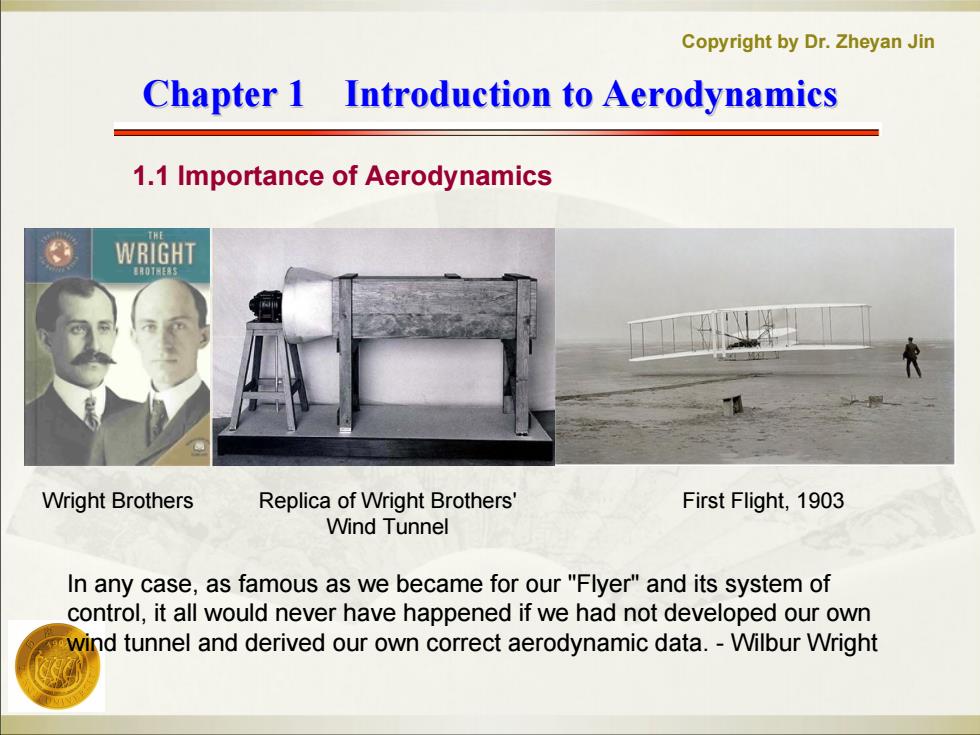
Copyright by Dr.Zheyan Jin Chapter 1 Introduction to Aerodynamics 1.1 Importance of Aerodynamics WRIGHT Wright Brothers Replica of Wright Brothers' First Flight,1903 Wind Tunnel In any case,as famous as we became for our"Flyer"and its system of control,it all would never have happened if we had not developed our own wind tunnel and derived our own correct aerodynamic data.-Wilbur Wright
Copyright by Dr. Zheyan Jin Chapter 1 Introduction to Aerodynamics Chapter 1 Introduction to Aerodynamics 1.1 Importance of Aerodynamics Replica of Wright Brothers' Wind Tunnel In any case, as famous as we became for our "Flyer" and its system of control, it all would never have happened if we had not developed our own wind tunnel and derived our own correct aerodynamic data. - Wilbur Wright Wright Brothers First Flight, 1903
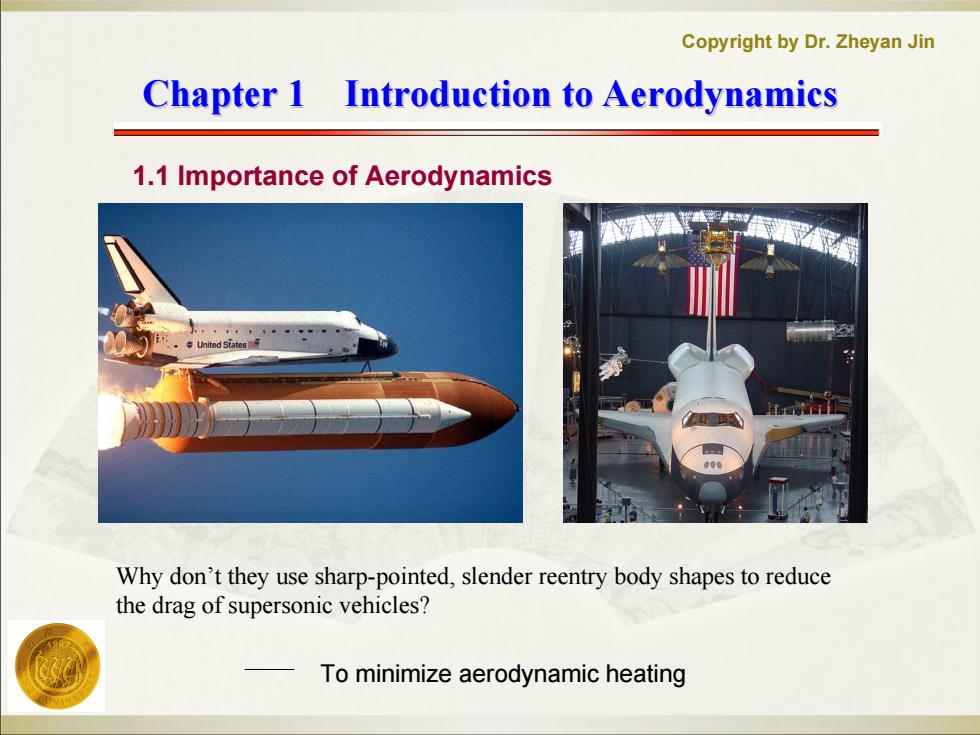
Copyright by Dr.Zheyan Jin Chapter 1 Introduction to Aerodynamics 1.1 Importance of Aerodynamics Why don't they use sharp-pointed,slender reentry body shapes to reduce the drag of supersonic vehicles? To minimize aerodynamic heating
Copyright by Dr. Zheyan Jin Chapter 1 Introduction to Aerodynamics Chapter 1 Introduction to Aerodynamics 1.1 Importance of Aerodynamics Why don’t they use sharp-pointed, slender reentry body shapes to reduce the drag of supersonic vehicles? To minimize aerodynamic heating
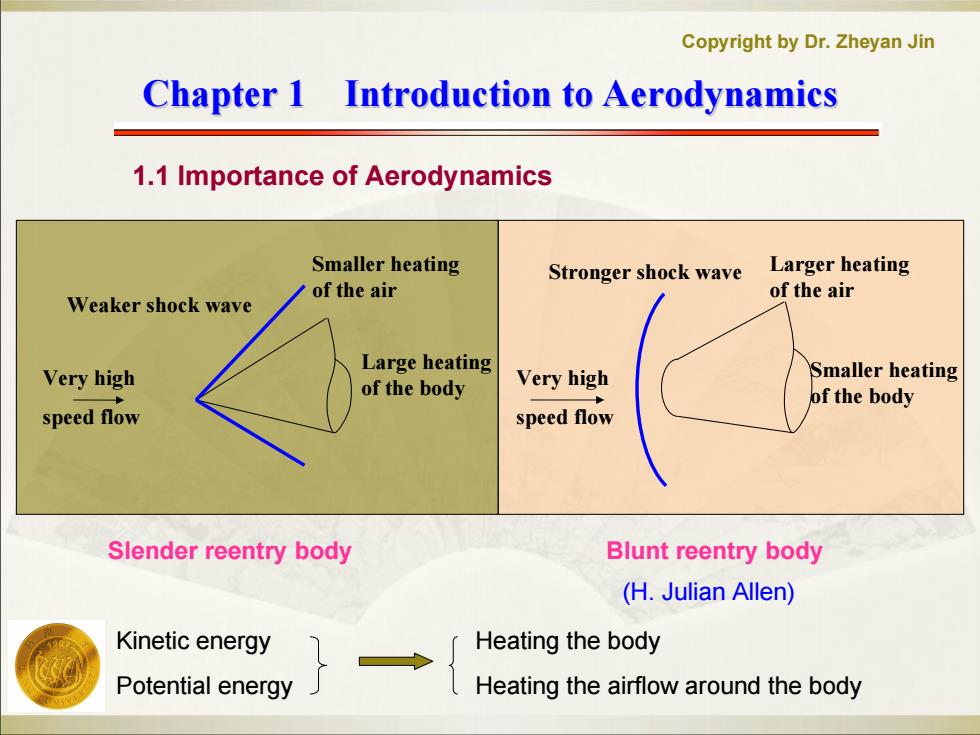
Copyright by Dr.Zheyan Jin Chapter 1 Introduction to Aerodynamics 1.1 Importance of Aerodynamics Smaller heating Stronger shock wave Larger heating of the air of the air Weaker shock wave Very high Large heating Very high Smaller heating of the body of the body speed flow speed flow Slender reentry body Blunt reentry body (H.Julian Allen) Kinetic energy Heating the body Potential energy Heating the airflow around the body
Copyright by Dr. Zheyan Jin Chapter 1 Introduction to Aerodynamics Chapter 1 Introduction to Aerodynamics 1.1 Importance of Aerodynamics Very high speed flow (H. Julian Allen) Smaller heating of the air L arge heating of the body Weaker shock w ave Very high speed flow Smaller heating of the body Stronger shock wave L arger h eating of the air Slender reentry body Blunt reentry body Heating the body Heating the airflow around the body Kinetic energy Potential energy
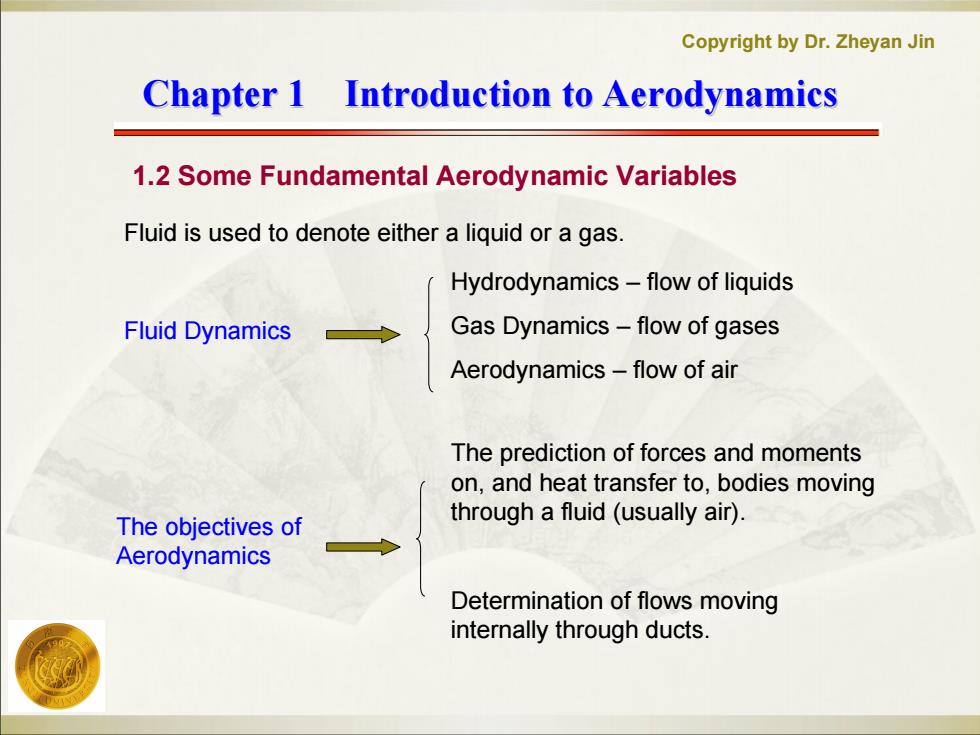
Copyright by Dr.Zheyan Jin Chapter 1 Introduction to Aerodynamics 1.2 Some Fundamental Aerodynamic Variables Fluid is used to denote either a liquid or a gas. Hydrodynamics-flow of liquids Fluid Dynamics Gas Dynamics-flow of gases Aerodynamics-flow of air The prediction of forces and moments on,and heat transfer to,bodies moving The objectives of through a fluid(usually air). Aerodynamics Determination of flows moving internally through ducts
Copyright by Dr. Zheyan Jin Chapter 1 Introduction to Aerodynamics Chapter 1 Introduction to Aerodynamics 1.2 Some Fundamental Aerodynamic Variables Fluid Dynamics Hydrodynamics – flow of liquids Gas Dynamics – flow of gases Aerodynamics – flow of air Fluid is used to denote either a liquid or a gas. The objectives of Aerodynamics The prediction of forces and moments on, and heat transfer to, bodies moving through a fluid (usually air). Determination of flows moving internally through ducts
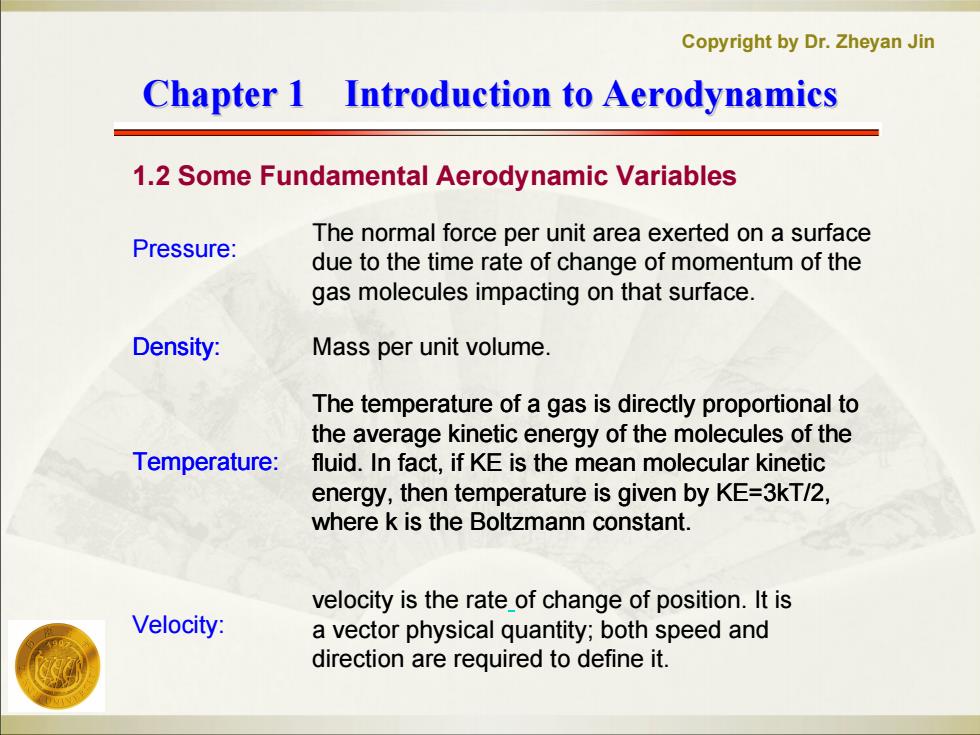
Copyright by Dr.Zheyan Jin Chapter 1 Introduction to Aerodynamics 1.2 Some Fundamental Aerodynamic Variables Pressure: The normal force per unit area exerted on a surface due to the time rate of change of momentum of the gas molecules impacting on that surface. Density: Mass per unit volume. The temperature of a gas is directly proportional to the average kinetic energy of the molecules of the Temperature: fluid.In fact,if KE is the mean molecular kinetic energy,then temperature is given by KE=3kT/2, where k is the Boltzmann constant. velocity is the rate of change of position.It is Velocity: a vector physical quantity;both speed and direction are required to define it
Copyright by Dr. Zheyan Jin Chapter 1 Introduction to Aerodynamics Chapter 1 Introduction to Aerodynamics 1.2 Some Fundamental Aerodynamic Variables Pressure: The normal force per unit area exerted on a surface due to the time rate of change of momentum of the gas molecules impacting on that surface. Density: Mass per unit volume. The temperature of a gas is directly proportional to the average kinetic energy of the molecules of the fluid. In fact, if KE is the mean molecular kinetic energy, then temperature is given by KE=3kT/2, where k is the Boltzmann constant. Temperature: velocity is the rate of change of position. It is a vector physical quantity; both speed and direction are required to define it. Velocity: The temperature of a gas is directly proportional to the average kinetic energy of the molecules of the fluid. In fact, if KE is the mean molecular kinetic energy, then temperature is given by KE=3kT/2, where k is the Boltzmann constant. Temperature:
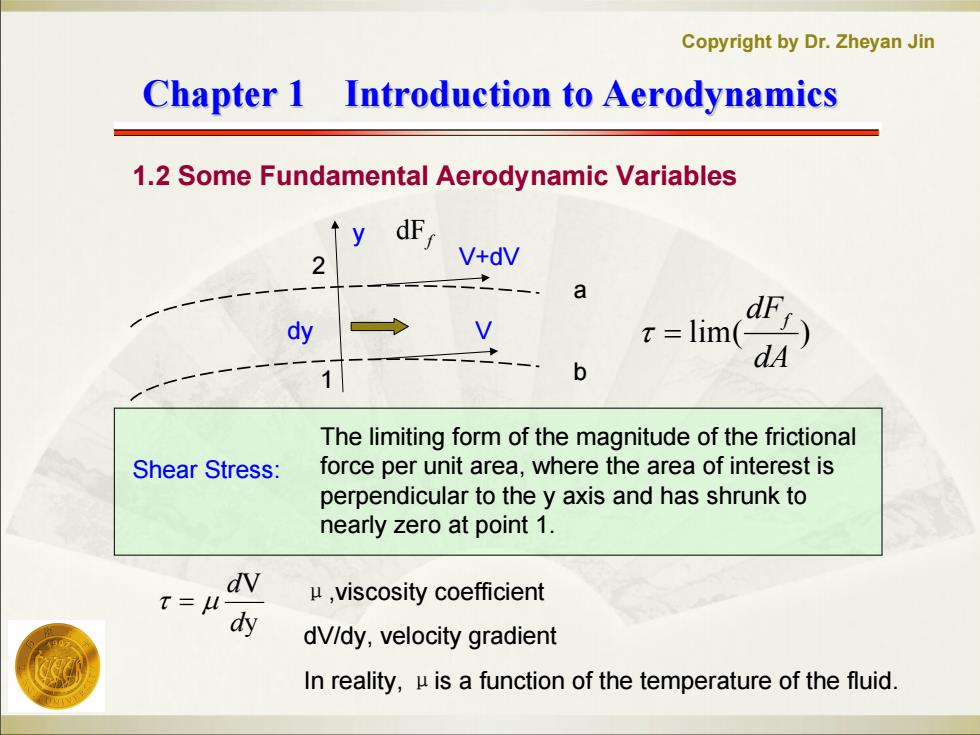
Copyright by Dr.Zheyan Jin Chapter 1 Introduction to Aerodynamics 1.2 Some Fundamental Aerodynamic Variables ↑yd V+dV 之-- dy t=lim( dA 1 The limiting form of the magnitude of the frictional Shear Stress: force per unit area,where the area of interest is perpendicular to the y axis and has shrunk to nearly zero at point 1. dv T=μ μ,viscosity coefficient y dV/dy,velocity gradient In reality,u is a function of the temperature of the fluid
Copyright by Dr. Zheyan Jin Chapter 1 Introduction to Aerodynamics Chapter 1 Introduction to Aerodynamics 1.2 Some Fundamental Aerodynamic Variables a b dy y V+dV V f dF y V d d 1 2 lim ( ) dA dFf The limiting form of the magnitude of the frictional force per unit area, where the area of interest is perpendicular to the y axis and has shrunk to nearly zero at point 1. Shear Stress: μ,viscosity coefficient dV/dy, velocity gradient In reality, μis a function of the temperature of the fluid
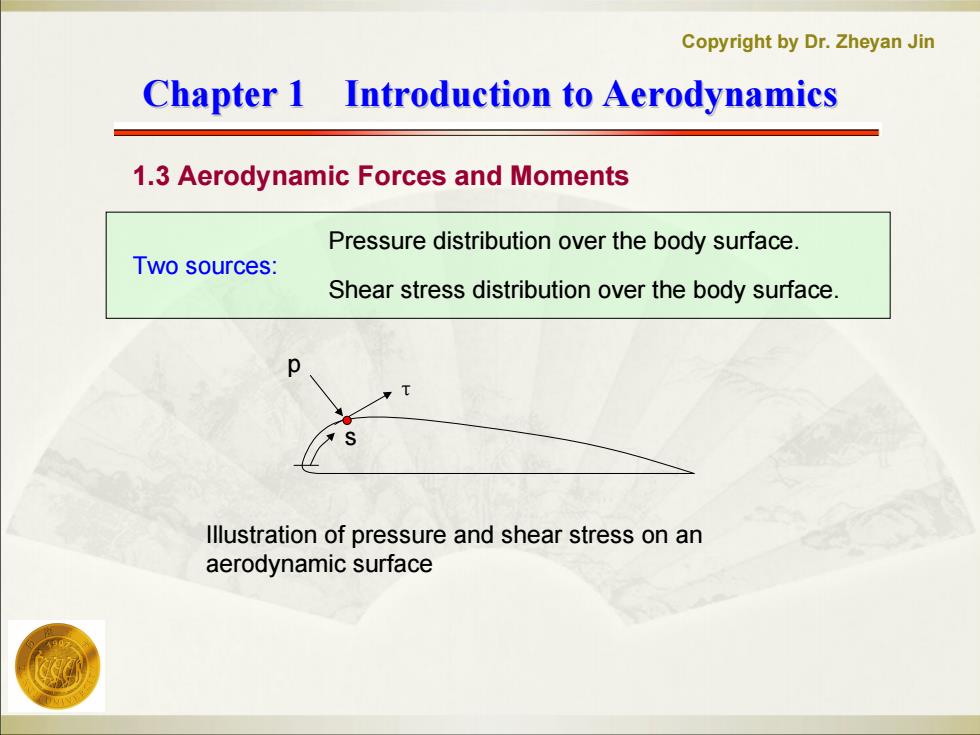
Copyright by Dr.Zheyan Jin Chapter 1 Introduction to Aerodynamics 1.3 Aerodynamic Forces and Moments Pressure distribution over the body surface. Two sources: Shear stress distribution over the body surface. Illustration of pressure and shear stress on an aerodynamic surface
Copyright by Dr. Zheyan Jin Chapter 1 Introduction to Aerodynamics Chapter 1 Introduction to Aerodynamics 1.3 Aerodynamic Forces and Moments Pressure distribution over the body surface. Two sources: Shear stress distribution over the body surface. τ p s Illustration of pressure and shear stress on an aerodynamic surface

Copyright by Dr.Zheyan Jin Chapter 1 Introduction to Aerodynamics 1.3 Aerodynamic Forces and Moments M R R Q L≡lit≡component of R perpendicular to D=drag component of R parallel to N=normal force component of R perpendicular to c A=axial force component of R parallel to c L=N cosa-Asina D=Nsina+Acosa
Copyright by Dr. Zheyan Jin Chapter 1 Introduction to Aerodynamics Chapter 1 Introduction to Aerodynamics 1.3 Aerodynamic Forces and Moments L ≡ lift ≡ component of R perpendicular to V V M R V D ≡ drag ≡ component of R parallel to α L c V N D R A α α N ≡ normal force ≡ component of R perpendicular to c A ≡ axial force ≡ component of R parallel to c sin cos L cos sin D N A N A

Copyright by Dr.Zheyan Jin Chapter 1 Introduction to Aerodynamics 1.3 Aerodynamic Forces and Moments S=planform area Area S I=c=chord length Dynamic pressure: The dimensionless force and moment coefficients: C=L 9.S CD=D 9.S 9.S C.=4 9.S 9.S7 Pressure coefficient: C。-p-p Skin friction coefficient: C1=-
Copyright by Dr. Zheyan Jin Chapter 1 Introduction to Aerodynamics Chapter 1 Introduction to Aerodynamics 1.3 Aerodynamic Forces and Moments l = c = ch o r d l ength 2 2 1 q V q p p C p V S= planform area Pressure coefficient: Skin friction coefficient: q Sl M q S A q S N q S D q S L L D N A M C C C C C c Area S Dynamic pressure: q f C The dimensionless force and moment coefficients: